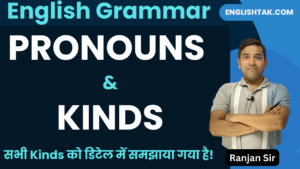![]()
Ditransitive Verb in English
Table of Contents
Ditransitive Verb in English – In this post, I am sharing a concept and rule regarding Ditransitive Verbs in English. This is considered to be one of the most important grammar rules of English Grammar. Let’s begin…
What is Ditransitive Verbs in English?
A ditransitive verb is a verb that takes both a direct object and an indirect object. In other words, it involves three elements: the subject, the direct object, and the indirect object. The Ditransitive verbs can transfer an action or state from the subject to the direct object, with the indirect object often indicating to or for whom the action is done.
Ditransitive Verb उस Verbs को कहा जाता है जो अपने साथ Direct और Indirect Object दोनो लेते है। इनकी संख्या English Language में बहुत काम इसलिए इन्हे याद करना आसान है।
Ditransitive Verb in English Examples
1. She gave him a book.
Subject: She
Ditransitive Verb: gave
Direct Object: a book
Indirect Object: him
In this sentence, “gave” is the ditransitive verb because it transfers the book (direct object) from the subject (she) to the indirect object (him).
It’s important to note that not all verbs can be ditransitive. Some verbs are only transitive (take a direct object) or intransitive (do not take a direct object). Ditransitive verbs add complexity to the sentence structure by involving both a direct and an indirect object.
यह ध्यान रखना महत्वपूर्ण है कि सभी क्रियाएँ Ditransitive नहीं हो सकतीं। कुछ क्रियाएँ केवल Transitive (जो सिर्फ Direct Object लेता है। ) या Intransitive (जो Object नहीं लेता है।) होती हैं। Ditransitive क्रियाएं प्रत्यक्ष और अप्रत्यक्ष दोनों Objects को शामिल करके वाक्य संरचना में जटिलता जोड़ती हैं।
Verbs with two objects
| Give lend offer |
pass post promise |
read sell |
send show |
tell write |
Ditransitive Verbs List
1. Give (देना):
English: She gave him a gift.
Hindi: उसने उसको एक उपहार दिया। (Usne usko ek uphaar diya.)
2. Send (भेजना):
English: I sent her a letter.
Hindi: मैंने उसको एक पत्र भेजा। (Maine usko ek patra bheja.)
3. Show (दिखाना):
English: He showed me the way.
Hindi: उसने मुझे रास्ता दिखाया। (Usne mujhe raasta dikhaya.)
4. Tell (बताना):
English: She told them a story.
Hindi: उसने उनको एक कहानी सुनाई। (Usne unko ek kahani sunayi.)
5. Offer (प्रस्तुत करना):
English: The waiter offered us a dessert.
Hindi: वेटर ने हमें एक मिठाई प्रस्तुत की। (Waiter ne hamein ek mithai prastut ki.)
6. Buy (खरीदना):
English: She bought her children new clothes.
Hindi: उसने अपने बच्चों को नए कपड़े खरीदे। (Usne apne bachchon ko naye kapde khareede.)
7. Promise (वादा करना):
English: I promised her a surprise.
Hindi: मैंने उसको एक चौंकाने का वादा किया। (Maine usko ek chaukane ka vaada kiya.)
8. Serve (सेवा करना):
English: The waiter served us a delicious meal.
Hindi: वेटर ने हमें एक स्वादिष्ट भोजन सेव किया। (Waiter ne hamein ek swadisht bhojan serve kiya.)
9. Show (प्रदर्शन करना):
English: The guide showed the tourists a historical monument.
Hindi: मार्गदर्शक ने पर्यटकों को एक ऐतिहासिक स्मारक दिखाया। (Margdarshak ne pariyaton ko ek aitihasik smarak dikhaya.)
10. Read (पढ़ना):
English: She read the children a bedtime story.
Hindi: उसने बच्चों को एक सोने का समय कहानी पढ़ी। (Usne bachchon ko ek sone ka samay kahani padhi.)
11. Buy (खरीदना):
English: He bought his girlfriend a beautiful necklace.
Hindi: उसने अपनी गर्लफ्रेंड को एक सुंदर हार खरीदी। (Usne apni girlfriend ko ek sundar haar khareedi.)
12. Sing (गाना):
English: She sang her friend a birthday song.
Hindi: उसने अपने दोस्त को एक जन्मदिन गाना गाया। (Usne apne dost ko ek janmadin gana gaya.)
These examples illustrate how these verbs can take both a direct object and an indirect object, conveying the action or transfer of something from the subject to the indirect object through the direct object.
English Grammar through Hindi
Present Indefinite Tense Exercise
Conditional Sentences in English





